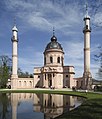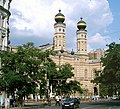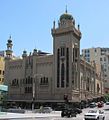Orientalism (art)

Under Orientalism in art refers to representations and (often imitative) uses Near and Far Eastern motifs by European artists.
Orientalism in Painting and the Applied Arts
Representations of "Moors" or "Turks" can be found here and there as early as the Middle Ages, not least in connection with armed conflicts. In the 18th century, based on the role of porcelain as an exclusive import good, the fashion of the chinoiseries spread in European castles, while distant China became a mythical place of wisdom , especially during the Enlightenment . In the 18th and 19th centuries, after the end of the expansionary phase of the Ottoman Empire and in connection with the increasing attempts at domination of European powers over the Islamic world, an almost romanticizing view of the Orient spread. Napoleon's military campaign in Egypt (1798–99) promoted interest in the era of the pharaohs and a corresponding fashion, primarily in the applied arts ( Egyptomania ), the Greek War of Independence (1821–1829), the Crimean War (1854–1855) and the opening the Suez Canal (1869) increased interest in the Middle East.
Numerous European painters of the 19th and early 20th centuries paid homage to the myth of the Orient as a place of sensuality and decadence . Above all, the harem scenes , which were very popular at the time , should be mentioned here. Eugène Delacroix , Théodore Frère , Jean-Léon Gérôme and later Alexandre Roubtzoff dedicated many of their works to the Islamic culture. Jean Auguste Dominique Ingres , head of the French Académie de peinture, painted his famous “Turkish Bath” in 1863. The sensuality of such scenes was made acceptable to the European world by the orientalizing decor.
There were also numerous “oriental painters” in the German cultural area, such as Gustav Bauernfeind , Eugen Bracht , Georg Macco , Adolf von Meckel , Leopold Carl Müller , Johann Victor Krämer and Carl Wuttke , who provided their bourgeois audience with sensual and picturesque scenes. Interest in the Orient and its architecture was also encouraged by the world exhibitions , namely those of 1855 and 1867 . Japonism , which emerged in the last third of the 19th century, influenced impressionist painters and artists such as Vincent van Gogh , who copied some of Hiroshige's woodcuts in his early years .
Orientalism in architecture
Motifs of oriental architecture already appeared as set pieces in numerous palace gardens of the 18th century. Examples are the “mosque” in the park of Schwetzingen Castle , corresponding buildings in Eisgrub (Lednice) or Kew . Numerous " pagodas " also date from this period . The steam engine house in the form of a mosque, which was built around the middle of the 19th century, is one of this type of exotic accessories. Here, too, the following applies: The elimination of the immediate warlike threat made it possible to deal with the stylistic elements of neighboring cultures more freely and in some cases in a more romantic way. In the late 19th century, plus the subject of growing commercial-style combination and the use occurs exotic architectures as an element of publicity , so when Yenidze -Zigarettenfabrik in Dresden , in the oriental architecture of Zacherlfabrik the raw material of Zacherl'schen Motte powder in Vienna (came from the Middle East), and at the Villa Crespi of a cotton industrialist with intensive trade contacts in the Arab region.
In general, in historicism, orientalizing décor was seen as part of the available stock of symbolically usable style elements and used for specialized construction tasks, for example for synagogues , for which the “Moorish style” became typical for a time. The same applied to the ritual architecture of numerous Masonic temples built between 1870 and 1930 in the USA, namely for buildings by the Shriners . Oriental décor was also used in the entertainment industry and for instruction, in particular at world exhibitions, in amusement parks and bars (e.g. Vauxhall (London), Tivoli (Copenhagen) and Bataclan (Paris)), in large cinemas from the silent film era ( e.g. Grauman's Chinese Theater or Grauman's Egyptian Theater ) and in the context of zoological gardens.
The “Red Mosque” in the Schwetzingen Palace Gardens was never intended as an Islamic house of worship. It was built as a garden folly between 1779 and 1793.
The pumping station for the Great Fountain in Sanssouci Park was built by Ludwig Persius from 1841 to 1843 "in the style of Turkish mosques with a minaret as a chimney" .
The Great Synagogue on Dohány Street, Budapest was inaugurated in 1859.
A Berlin landmark in the "Moorish" style: The New Synagogue (inaugurated in 1866, interior destroyed in 1938)
The Spanish Synagogue in Prague was decorated with rich ornaments in the Moorish style from 1882–83.
The Zacherlfabrik in Vienna is one of the rare examples of a commercially motivated orientalizing historicism in European architecture (built between 1888 and 1892)
Orientalism in the amusement park: Pagoda in Tivoli in Copenhagen .
Café Orient was a gastronomic establishment in Wiesbaden (built in 1899, demolished in 1964)
The synagogue in Sofia , an impressive orientalizing sacred building, built in 1909.
The Tripoli Shrine Temple (Milwaukee) opened in 1928.
The Forum Theater in Melbourne, Australia (opened 1929)
Orientalism in Music, Literature and Film
Both in European art music as well as in everyday and popular music of the past centuries, influences from the Orient and orientalizing fashion trends can be observed. This applies, among other things, to Janissary music, which had a significant influence on the development of European marching music, but also to the genre of opera and operetta - from Wolfgang Amadeus Mozart's Die Entführung aus dem Seragl to Giacomo Puccini's Madama Butterfly and Turandot to Franz Lehár's Land des Smiles and The Mikado by Gilbert & Sullivan . As in the field of the visual arts, there is often a romanticizing and sentimentalizing use of exotic motifs (such as the pentatonic scale ); the stage works often pay homage to the erotic charm of Far Eastern femininity.
In the field of “high” literature, Orientalism is evident in examples such as Montesquieus Lettres persanes , Goethe's West-Eastern Divan and the work of Pierre Loti should also be mentioned. The oriental decor in numerous of Karl May's (fictional) travelogues is characteristic . Numerous silent films, such as B. Sumurun by Ernst Lubitsch or L'Atlantide by Jacques Feyder demonstrate the interest in orientalist acts and exotic decorations even in the early phases of film history. This fascination is continued in the trivial literature of the 20th century and the films based on it, from The Tiger of Esnapur to the ironic paraphrases of the Indiana Jones series.
literature

- Exhibition catalogs of the exhibition cluster Exotic Worlds-European Fantasies . Stuttgart 1987, including above all:
- Stefan Koppelkamm : Exotic Architectures in the 18th and 19th Centuries . Ernst, Berlin 1987, ISBN 3-433-02274-7 , (also published as: The imaginary Orient. Exotic buildings of the 18th and 19th centuries in Europe ).
- Gérard-Georges Lemaire: Orientalism. The image of the Orient in painting . Könemann, Cologne 2000, ISBN 3-89508-891-9 .
- Nadine Beautheac, Francois-Xavier Bouchart: L'Europe exotique . Chene, Paris 1985, ISBN 2-85108-404-6 .
- Jean-Marcel Humbert: L'egyptomanie dans l'art occidental . ACR, Paris 1989, ISBN 2-86770-037-X .
- Kristian Davies: The Orientalists. Western Artists in Arabia, the Sahara, Persia and India . Laynfaroh, New York NY 2005, ISBN 0-9759783-0-6 .
- William D. Moore: Masonic Temples. Freemasonry, Ritual Architecture, and Masculine Archetypes . University of Tennessee Press, Knoxville TN 2006, ISBN 1-57233-496-7 .
- Gereon Sievernich and Hendrik Budde (eds.): Europe and the Orient 800 - 1900. Gütersloh, Munich 1989. Volume 1: Exhibition catalog. Volume 2: Reader for the exhibition. An exhibition from May 28 to August 27, 1989 as part of the 4th Horizontefestival Horizonte Festival of World Cultures 1989 in Martin-Gropius-Bau , Berlin.
- Ali Osman Öztürk : Alman Oryantalizmi , İstanbul 2015 (German summaries).
Web links
- Orientalism
- Exhibition in the Kunsthalle Krems: Harem - Secret of the Orient (PDF file; 63 kB)
- On the influence of Japanese woodblock prints on van Gogh
- Orientalism discussion and oriental painter . (Related to Edward Said )













